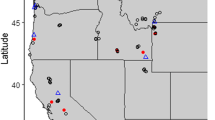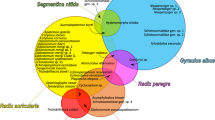Abstract
The role of parasites in a marine invasion was assessed by first examining regional patterns of trematode parasitism in the introduced Japanese mud snail, Batillaria cumingi (= B. attramentaria), in nearly all of its introduced range along the Pacific Coast of North America. Only one parasite species, which was itself a non-native species, Cercaria batillariae was recovered. Its prevalence ranged from 3 to 86%. Trematode diversity and prevalence in B. cumingi and a native sympatric mud snail, Cerithidea californica, were also compared in Bolinas Lagoon, California. Prevalence of larval trematodes infecting snails as first intermediate hosts was not significantly different (14% in B. cumingi vs 15% in C. californica). However, while the non-native snail was parasitized only by one introduced trematode species, the native snail was parasitized by 10 native trematode species. Furthermore, only the native, C. californica, was infected as a second intermediate host, by Acanthoparyphium spinulosum(78% prevalence). Given the high host specificity of trematodes for first intermediate hosts, in marshes where B. cumingi is competitively excluding C. californica, 10 or more native trematodes will also become locally extinct.
Similar content being viewed by others
References
N Adachi K Wada (1998) ArticleTitleDistribution of two gastropods, Batillaria multiformis and B. cumingi (Batillariidae) at a co-occuring area Venus(Japanese Journal of Malacology) 57 115–120
JD Andrews (1980) ArticleTitleA review of introductions of exotic oysters and biological planning for new importations Marine Fisheries Review 42 1–11
L Augustine G Muller-Parker (1998) ArticleTitleSelective predation by the mosshead sculpin Clinocottus globiceps on the sea anemone Anthopleura elegantissima and its two algal symbionts Limnology and Oceanography 43 711–715
Barrett EM (1963) The California oyster industry. California Department Fish and Game, Fish Bulletin 123:2–103
AM Barse DH Secor (1999) ArticleTitleAn exotic nematode parasite of the American eel Fisheries 24 6–11 Occurrence Handle10.1577/1548-8446(1999)024<0006:AATRSH>2.0.CO;2
S Behrens Yamada CS Sankurathri (1977) ArticleTitleDirect development in the intertidal gastropod B. zonalis Veliger 20 179
P Bonnot (1935) ArticleTitleThe California oyster industry California Fish and Game 21 65–80
AO Bush KD Lafferty JM Font AW Shostak (1997) ArticleTitleParasitology meets ecology: definitions, clarifications, examples and Margolis et al. revisited Journal Parasitology 83 575–583
JE Byers (1999) ArticleTitleThe distribution of an introduced mollusc and its role in the long-term demise of a native confamilial species Biological Invasions 1 339–352 Occurrence Handle10.1023/A:1010038001768
JE Byers (2000a) ArticleTitleCompetition between two estuarine snails: implications for invasions of exotic species Ecology 81 1225–1239
JE Byers (2000b) ArticleTitleDifferential susceptibility to hypoxia aids estuarine invasion Marine Ecology Progress Series 203 123–132
JE Byers L Goldwasser (2001) ArticleTitleExposing the mechanism and timing of impact of non-indigenous species on native species Ecology 82 1330–1343
JT Carlton (1975) ArticleTitleExtinct and endangered populations of the endemic mud snail Cerithidea californica in Northern California Bulletin of the American Malacological Union 41 65–66
HL Ching (1991) ArticleTitleLists of larval worms from marine invertebrates of the Pacific Coast of North America Journal of Helminthological Society Washington 58 57–68
AJ Crivelli (1983) ArticleTitleThe destruction of aquatic vegetation by carp Hydrobiologia 106 37–42 Occurrence Handle10.1007/BF00016414
WF Font DC Tate (1994) ArticleTitleHelminth parasites of native Hawaiian freshwater fishes: an example of extreme ecological isolation Journal of Parasitology 80 682–688 Occurrence Handle7931902
WJ Freeland (1983) ArticleTitleParasites and the coexistence of animal host species American Naturalist 121 223–236 Occurrence Handle10.1086/284052
M Harada S Suguri (1989) ArticleTitleSurveys on cercariae in brackish water snails in Kagawa Prefecture, Shikoku, Japan Japanese Journal of Parasitology 38 388–391
CJ Hayward M Iwashita JS Crane K Ogawa (2001) ArticleTitleFirst report of the invasive eel pest Pseudodactylogyrus biniin North America and in wild American eels Diseases of Aquatic Organisms 44 53–60 Occurrence Handle11253875
DH Heyneman K Lim U Jeyarasasingam (1972) ArticleTitleAntagonism of Echinostoma liei (Trematoda: Echinostomatidae) against the trematodes Paryphostomum segregatum and Schistosoma mansoni Parasitology 65 223–233 Occurrence Handle4680535
JC Holmes WM Bethel (1972) Modification of intermediate host behavior by parasites EU Canning CA. Wright (Eds) Behavioral Aspects of Parasite Transmission Academic Press London 123–149
JC Holmes D Minchin (1995) ArticleTitleTwo exotic copepods imported into Ireland with Pacific oyster Crassostrea gigas (Thunberg) Irish Naturalist’s Journal 25 17–20
RD Holt (1984) ArticleTitleSpatial Heterogeneity, indirect interactions, and the coexistence of prey species American Naturalist 124 377–406 Occurrence Handle10.1086/284280
RD Holt JH Lawton (1994) ArticleTitleThe ecological consequences of shared natural enemies Annual Review of Ecology and Systematics 25 495–520 Occurrence Handle10.1146/annurev.es.25.110194.002431
TC Huspeni KD Lafferty (2004) ArticleTitleUsing larval trematodes that parasitize snails to evaluate a salt-marsh restoration project Ecological Applications 14 795–804
J Ito (1988) ArticleTitleA subsequent monograph of cercariae in Japan Japanese Journal of Parasitology 37 269–322
AM Kuris (1974) ArticleTitleTrophic interactions: similarity of parasitic castrators to parasitoids Quarterly Review of Biology 49 129–148 Occurrence Handle10.1086/408018
AM Kuris (1997) Host behavior modification an evolutionary perspective NE. Beckage (Eds) Parasites and Pathogens Effects on Host Hormones and Behavior Chapman Hall New York 293–315
AM Kuris J Warren (1980) ArticleTitleEchinostome cercarial penetration and metacercarial encystment as mortality factors for a second intermediate host, Biomphalaria glabrata Journal of Parasitology 66 630–635 Occurrence Handle7420245
KD Lafferty (1991) Effects of parasitic castration on the salt marsh snail, Cerithidea californica University of California Santa Barbara
KD Lafferty (1992) ArticleTitleForaging on prey that are modified by parasites American Naturalist 140 854–867 Occurrence Handle10.1086/285444
KD Lafferty (1993) ArticleTitleEffects of parasitic castration on growth, reproduction and population dynamics of the marine snail Cerithidea californica Marine Ecology Progress Series 96 229–237
KD Lafferty (1999) ArticleTitleThe evolution of trophic transmission Parasitology Today 15 111–115 Occurrence Handle10.1016/S0169-4758(99)01397-6 Occurrence Handle10322324
KD Lafferty AM Morris (1996) ArticleTitleAltered behavior of parasitized killifish increases susceptibility to predation by final bird hosts Ecology 77 1390–1397
HK Lim D Heyneman (1972) ArticleTitleIntramolluscan intertrematode antagonism: a review of factors influencing the host-parasite system and its possible role in biological control Advances in Parasitology 10 191–268 Occurrence Handle4559144
J Llewellyn (1965) The evolution of parasitic platyhelminths AER Taylor (Eds) Evolution of Parasites Blackwell Scientific Publications Oxford 47–78
WE Martin (1972) ArticleTitleAn annotated key to the cercariae that develop in the snail Cerithidea californica Bulletin of Southern California Academy of Science 71 39–43
WE Martin JE Adams (1961) ArticleTitleLife cycle of Acanthoparyphium spinulosum Johnston, 1917 (Echinostomatidae: Trematoda) Journal of Parasitology 47 777–782 Occurrence Handle14470450
DJ Minchella ME Scott (1991) ArticleTitleParasitism: a cryptic determinant of animal community structure Trends in Ecology and Evolution 6 250–254 Occurrence Handle10.1016/0169-5347(91)90071-5
AJ Mitchell MJ Salmon DG Huffman AE Goodwin TM Brant (2000) ArticleTitlePrevalence and pathogenicity of a heterophyid trematode infecting the gills of an endangered fish, the fountain darter, in two central Texas spring-fed rivers Journal of Aquatic Animal Health 12 283–289 Occurrence Handle10.1577/1548-8667(2000)012<0283:PAPOAH>2.0.CO;2
RH Morris DP Abbott EC Haderlie (1980) Intertidal Invertebrates of California Stanford University Press Stanford, California
Osmanov SO (1971) Parasites of fishes of Uzbekistan. Tashkent: FAN (in Russian)
T Ozawa (1996) ArticleTitleA new species of Batillaria (Gastropoda: Batillariidae) from Japan Venus(Japanese Journal of Malacology) 55 189–197
T Park (1948) ArticleTitleExperimental studies of interspecific competition. I. Competition between populations of flour beetles Tribolium confusum Duval and T. castaneum Herbst Ecological Monographs 18 265–307
PW Price M Westoby B Rice (1988) ArticleTitleParasite-mediated competition: some predictions and tests American Naturalist 131 544–555 Occurrence Handle10.1086/284805
GM Ruiz P Fofonoff AH Hines ED Grosholz (1999) ArticleTitleNon-indigenous species as stressors in estuarine and marine communities: assessing invasion impacts and interactions Limnology and Oceanography 44 950–972
AV Rybakov OG Lukomskaya (1988) ArticleTitleOn the life cycle of Acanthoparyphium macracanthum sp.n Trematoda, Echinostomatidae. Parazitologiya 22 224–229
JJ Schall (1992) ArticleTitleParasite-mediated competition in Anolis lizards Oecologia 92 58–64 Occurrence Handle10.1007/BF00317262
D Secord P Kareiva (1996) ArticleTitlePerils and pitfalls in the host specificity paradigm BioScience 46 448–453
S Shimura J Ito (1980) ArticleTitleTwo new species of marine cercariae from the Japanese intertidal gastropod, Batillaria cumingi(Crosse) Japanese Journal of Parasitology 29 369–375
WL Shoop (1988) ArticleTitleTrematode transmission patterns Journal of Parasitology 74 46–59 Occurrence Handle3282054
WP Sousa (1983) ArticleTitleHost life history and the effect of parasitic castration on growth: a field study of Cerithidea californica Haldeman (Gastropoda: Prosobranchia) and its trematode parasites Journal of Experimental Marine Biology and Ecology 73 273–296 Occurrence Handle10.1016/0022-0981(83)90051-5
WP Sousa (1990) Spatial scale and the processes structuring a guild of larval trematode parasites GW Esch AO Bush JM Aho (Eds) Parasite Communities: Patterns and Processes Chapman and Hall New York 41–67
ME Torchin KD Lafferty AM Kuris (2001) ArticleTitleRelease from parasites as natural enemies: increased performance of a globally introduced marine crab Biological Invasions 3 333–345 Occurrence Handle10.1023/A:1015855019360
ME Torchin KD Lafferty AM Kuris (2002) ArticleTitleParasites and marine invasions Parasitology 124 137–151 Occurrence Handle10.1017/S0031182002001506 Occurrence Handle11862992
ME Torchin KD Lafferty AP Dobson VJ McKenzie AM Kuris (2003) ArticleTitleIntroduced species and their missing parasites Nature 421 628–630 Occurrence Handle10.1038/nature01346 Occurrence Handle12571595
Whitlatch RB (1972) The ecology, life history and feeding biology of Batillaria zonalis. Masters thesis, University of the Pacific
RB Whitlatch (1974) ArticleTitleStudies on the population ecology of the salt marsh gastropod Batillaria zonalis Veliger 17 47–55
RB Whitlatch S Obrebski (1980) ArticleTitleFeeding selectivity and coexistence in two deposit feeding gastropods Marine Biology 58 219–225 Occurrence Handle10.1007/BF00391879
S Yamaguti (1971) Synopsis of digenetic trematodes of vertebrates NumberInSeries(Vol. 1 and 2) Keigaku Publishing Company Tokyo, Japan
S Yamaguti (1975) A synoptical review of life histories of digenetic trematodes of vertebrates with special reference to the morphology of their larval forms Keigaku Publishing Company Tokyo, Japan
Author information
Authors and Affiliations
Corresponding author
Rights and permissions
About this article
Cite this article
Torchin, M.E., Byers, J.E. & Huspeni, T.C. Differential Parasitism of Native and Introduced Snails: Replacement of a Parasite Fauna. Biol Invasions 7, 885–894 (2005). https://doi.org/10.1007/s10530-004-2967-6
Received:
Accepted:
Issue Date:
DOI: https://doi.org/10.1007/s10530-004-2967-6




